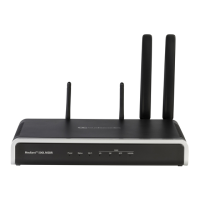User's Manual 67. Configuration Parameters Reference
Version 6.8 983 Mediant 500L MSBR
Parameter Description
The correct dial tone parameters must be configured in
the CPT file.
The device may take 1 to 3 seconds to detect a dial tone
(according to the dial tone configuration in the CPT file). If
the dial tone is not detected within 6 seconds, the device
releases the call and sends a SIP 500 "Server Internal
Error” response.
Web: Time to Wait before Dialing
[msec]
EMS: Time Before Dial
CLI: time-wait-b4-dialing
[WaitForDialTime]
For digital interfaces: Defines the delay after hook-flash is
generated and until dialing begins. Applies to call transfer
(i.e., the parameter TrunkTransferMode is set to 3) on CAS
protocols.
For analog interfaces: Defines the delay before the device
starts dialing on the FXO line in the following scenarios:
The delay between the time the line is seized and dialing
begins during the establishment of an IP-to-Tel call.
Note: Applicable only for one-stage dialing when the
parameter IsWaitForDialTone is disabled.
The delay between detection of a Wink and the start of
dialing during the establishment of an IP-to-Tel call (for
DID lines, see the EnableDIDWink parameter).
For call transfer - the delay after hook-flash is generated
and dialing begins.
The valid range (in milliseconds) is 0 to 20,000 (i.e., 20
seconds). The default is 1,000 (i.e., 1 second).
Web: Ring Detection Timeout [sec]
EMS: Timeout Between Rings
CLI: ring-detection-tout
[FXOBetweenRingTime]
Defines the timeout (in seconds) for detecting the second
ring after the first detected ring.
If automatic dialing is not used and Caller ID is enabled, the
device seizes the line after detection of the second ring
signal (allowing detection of caller ID sent between the first
and the second rings). If the second ring signal is not
received within this timeout, the device doesn't initiate a call
to IP.
If automatic dialing is used, the deviceinitiates a call to IP
when the ringing signal is detected. The FXO line is seized
only if the remote IP party answers the call. If the remote
party doesn't answer the call and the second ring signal is
not received within this timeout, the device releases the IP
call.
This parameter is typically set to between 5 and 8. The
default is 8.
Notes:
This parameter is applicable only for Tel-to-IP calls.
This timeout is calculated from the end of the ring until
the start of the next ring. For example, if the ring cycle is
two seconds on and four seconds off, the timeout value
should be configured to five seconds (i.e., greater than
the off time, e.g., four).
Web: Rings before Detecting Caller ID
EMS: Rings Before Caller ID
CLI: rings-b4-det-callerid
[RingsBeforeCallerID]
Determines the number of rings before the device starts
detecting Caller ID.
[0] 0 = Before first ring.
[1] 1 = (Default) After first ring.

